Low code automation tools play a critical role in businesses by speeding up development processes while demanding minimal coding skills. They simplify application and workflow creation, slashing the time and resources typically required for development. This accessibility empowers non-technical users to contribute to software solutions, driving innovation and accelerating time-to-market for businesses.
At Aloa, we've conducted comprehensive research on low code automation tools for startups to facilitate streamlined application development processes. We've curated a comprehensive list of the leading low code automation tools customized to meet your requirements. You can rely on us to provide all the necessary details for selecting a tool that perfectly aligns with your needs.
In this blog post, we'll explore the best low code automation tools for startups in 2024 designed to streamline workflows and boost efficiency. We'll explore their standout features, pricing, and advantages, illustrating their effective integration into your operations. Moreover, we'll assist you in choosing the ideal low code automation tools aligning with your unique business requirements.
Afterwards, you'll have a comprehensive list that perfectly matches your needs. Stay in the loop as we unravel the potential of these tools, enabling you to optimize workflows and boost productivity in your operations in 2024.
Let’s get started!
Best Low Code Automation Tools For Startups in 2024
Low code automation tools simplify the development process by reducing the need for extensive coding knowledge. Choosing the right one is vital, as it can significantly impact project efficiency and outcomes. Let’s explore the best low code automation tools to boost your productivity in 2024.
1. Parasoft - Providing Automation and AI-Powered Solutions
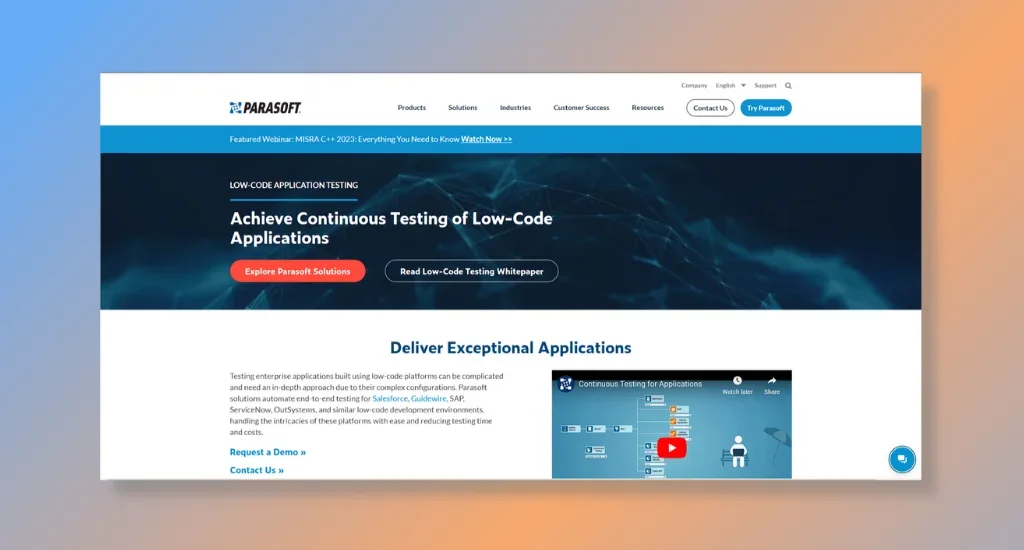
Parasoft specializes in offering automation and AI-powered solutions tailored for low-code application testing. Their expertise simplifies the complexities of testing enterprise applications built on platforms like Salesforce, SAP, and Guidewire.
They offer automation and AI-powered services tailored for thorough testing of low-code applications. They streamline UI testing, automate API testing, use AI for robust test scenarios, and provide service virtualization for uninterrupted testing across interconnected platforms.
Notable Features of Working with Parasoft
- AI-Powered Testing: Parasoft employs AI to create comprehensive test scenarios and simplify the testing process for complex low-code applications.
- UI Testing Streamlining: Provides a simple Chrome plugin to record manual UI interactions and build Selenium tests for ongoing maintainability.
- Comprehensive API Testing: Automates API test scenario creation for functional and load testing, maximizing test coverage.
- Service Virtualization: Enables simulating unavailable systems and services, ensuring uninterrupted testing for businesses relying on various interconnected platforms.
Parasoft’s Pricing Plans
Parasoft's pricing plans are typically tailored to the specific needs of businesses, depending on the scale and scope of testing required. Fill out the form on their website with your details to book a demo or start a free trial.
Businesses across industries, including finance, hospitality, telecommunications, retail, government, healthcare, and insurance, benefit from Parasoft's automation tools for low-code applications. Clients include major corporations seeking efficient and reliable testing solutions.
2. Testifi CAST - Facilitating Efficient Testing Throughout the Software Development Lifecycle
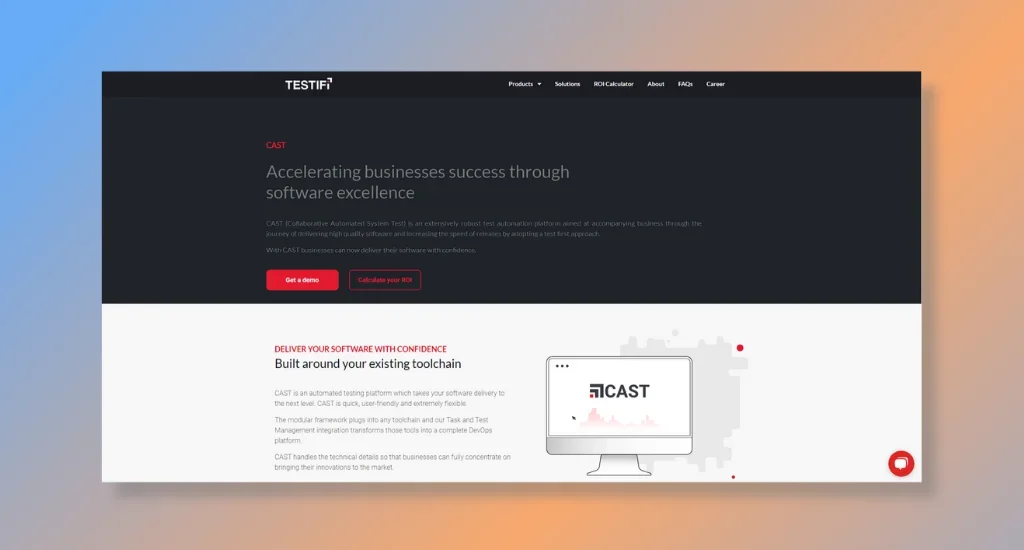
Testifi CAST excels in providing a robust automated testing platform that integrates seamlessly with low code automation tools. Their expertise lies in delivering high-quality software by adopting a test-first approach.
They offer comprehensive services centered around automating and optimizing software testing processes. They provide a robust testing platform that seamlessly integrates with existing toolchains. With a focus on a test-first approach, CAST ensures quick adaptability, enhanced flexibility, and streamlined testing cycles.
Notable Features of Working with Testifi CAST
- Low Code Integration: Seamlessly integrates with various low code automation tools.
- Quick Adaptability: Swiftly plugs into existing toolchains for low code integration.
- Enhanced Flexibility: Highly customizable interface aligning with low code automation needs.
- Optimized Testing Cycles: Minimizes manual efforts by leveraging low code automation for streamlined testing processes.
Testifi CAST’s Pricing Plans
Testifi CAST offers flexible pricing plans tailored to diverse business needs. You can fill out their inquiry form to discuss your testing needs for customized pricing.
They collaborate with various businesses spanning industries such as fintech, healthcare, and e-commerce. Their expertise in low code automation tools caters to startups aiming for rapid growth, medium-sized enterprises seeking scalability, and large corporations optimizing workflows.
3. Tricentis - Enhancing Software Testing Processes for Businesses
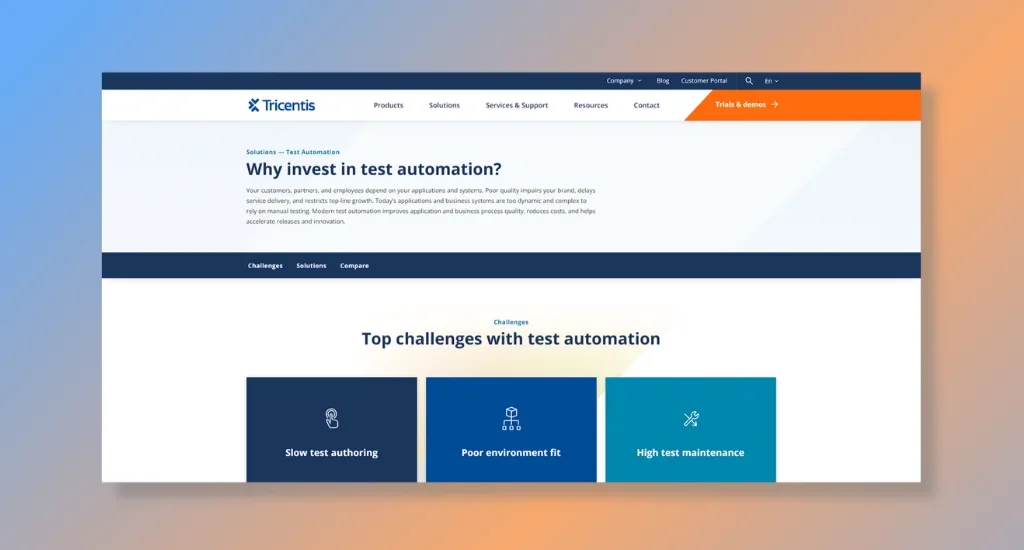
Tricentis excels in providing comprehensive low-code test automation solutions. Their proficiency lies in offering a range of tools like Tosca and Testim, enabling businesses to automate complex testing processes efficiently.
These tools offer features like AI-powered authoring, self-healing tests, and broad application support, resulting in reduced maintenance overhead and increased productivity. Clients leveraging Tricentis gain access to cutting-edge low code automation tools that enhance testing speed and coverage.
Notable Features of Working with Tricentis
- AI-Powered Authoring: Tricentis offers AI-driven test authoring capabilities, simplifying and accelerating the creation of automated tests without extensive coding requirements.
- Self-Healing Tests: Their tools include self-healing capabilities that minimize maintenance efforts by automatically adjusting tests to application changes.
- Broad Application Support: The platform supports various applications, offering versatility and adaptability for diverse testing needs.
- Low-Code Automation: Tricentis emphasizes low-code automation, empowering users to create and execute tests efficiently with minimal manual coding.
Tricentis’ Pricing Plans
Tricentis provides flexible pricing plans tailored to the needs of businesses, offering scalable options for accessing their suite of low code automation tools. They provide an option to request a demo or consultation using a form on their website. You can fill in your information and any particular inquiries or requirements about their services.
They partner with diverse businesses across technology, finance, healthcare, and telecommunications industries. These industries benefit from Tricentis' low code automation tools to streamline testing processes, improve product quality, and expedite software releases. Clients benefit from enhanced testing capabilities that cater specifically to their industry needs.
Best Low Code Automation Tools For Integration Testing
Choosing the right low code automation tools is essential for your development efficiency. These tools can accelerate cycles, enhance collaboration, and streamline deployment. Pick the best fit for scalability and needs, and you'll see improved agility, cost-effectiveness, and faster time-to-market in your projects.
4. AccelQ - Providing a Comprehensive Codeless Test Automation Platform

ACCELQ specializes in providing a comprehensive codeless test automation tool that excels in handling integration testing through low code methodologies. Their platform enables users to develop complex test logic without programming syntax.
They offer a design-first approach that ensures modularity and reusability, easing change management in integration testing scenarios. They empower clients in integration testing, enabling automation of diverse aspects like dynamic UI controls, functional data definition, automated test case generation, and business-focused test plan creation.
Notable Features of Working with AccelQ
- Complex Test Logic Development: Easily develop intricate test logic without programming.
- Design-First Approach: Promotes modularity and reusability in integration test assets.
- Comprehensive Automation: Enables automation across various integration testing aspects.
- Addressing Real-World Complexities: Solutions cater to intricate testing challenges.
ACCELQ’s Pricing Plans
ACCELQ offers flexible pricing models based on the scale and requirements of businesses, including specific packages for low code automation tools in integration testing. To view their pricing plans, visit their official website or contact their sales team for detailed information on available tiers and pricing options.
They serve various industries, including financial services, healthcare, telecom, insurance, retail, travel, entertainment, public sector, and ed-tech. The platform minimizes the reliance on traditional code development, allowing users to focus on higher-level functionalities.
5. Subject7 - Providing a Unified Testing Platform

Subject7 offers a unified testing platform that excels in low code automation tools for integration testing. Their expertise lies in providing a single codeless user interface that empowers technical and non-technical users to create and execute robust test flows seamlessly.
They offer a comprehensive suite of services centered around a unified testing platform. With a focus on integration testing, their platform caters to various testing needs, allowing seamless scalability, efficient integration capabilities, and streamlined end-to-end test automation for functional and non-functional requirements.
Notable Features of Working with Subject7
- Codeless Automation: Empowers users without coding expertise to create and execute test cases effortlessly.
- Unified Testing Solution: Offers a single platform catering to various testing needs, promoting efficient integration testing.
- Scalability: Enables thousands of tests in parallel, supporting diverse networks, platforms, and environments.
- Integration Capabilities: Seamlessly integrates with Agile and DevOps ecosystems, facilitating smooth integration testing.
Subject7’s Pricing Plans
Subject7 provides flexible pricing plans tailored to a wide range of business needs, offering scalable options suitable for enterprises seeking advanced integration testing solutions. Fill out the required details on their form or reach out through the provided contact channels to book a demo with them.
They work with various enterprises, including Moyral, Altum, PWC, and Federal Aviation, offering low code automation tools for integration testing. Clients benefit from diverse industries leveraging Subject7's platform to enhance testing efficiency and integration capabilities.
6. Mabl - Enabling Smooth Integration of Automated End-to-End Tests
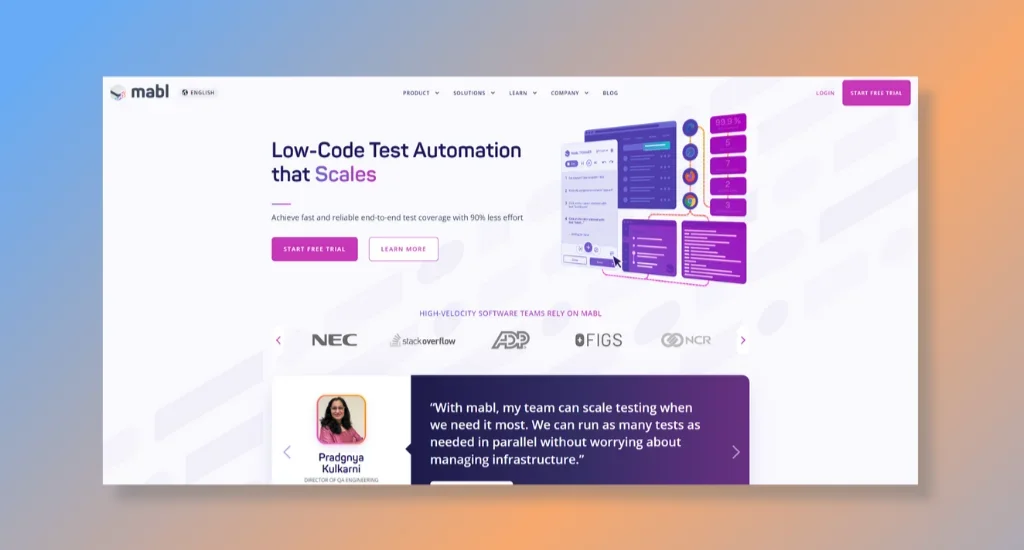
Mabl specializes in offering a leading intelligent, low-code test automation solution. They focus on enabling high-velocity software teams to integrate automated end-to-end tests across the development lifecycle seamlessly. They emphasize the ease of creating, executing, and maintaining reliable tests for browsers, APIs, and mobile web applications.
Their platform provides clients with a unified solution for quickly creating, executing and maintaining automated browser, API, and mobile web tests. For businesses, this means accelerated delivery of high-quality applications, reduced manual testing efforts, and increased coverage through their low code automation tools for integration testing aspects.
Notable Features of Working with Mabl
- Low-Code Functionality: Simplifies the creation and maintenance of integration tests, reducing the need for extensive coding knowledge.
- Comprehensive Coverage: Ensures robust end-to-end test coverage, including API tests and integration scenarios.
- Scalability: Allows for easy scaling of integration tests, accommodating growing software complexities.
- Auto-Healing: Detects and rectifies issues in tests, minimizing the time spent fixing and maintaining integration test suites.
Mabl’s Pricing Plans
Mabl offers pricing plans tailored to various business needs, providing flexible options based on usage and scale. To request a demo or start a free trial with Mabl, visit their official website and navigate to the respective tab. Fill out their form with your details and some information about your testing requirements.
They collaborate with diverse industries, including technology, finance, healthcare, and retail. Clients benefit from the platform's integration testing capabilities, facilitating faster time-to-market and improved software reliability.
Best Low Code Automation Tools For Performance Testing
Selecting the right low code automation tools for performance testing is crucial. These tools craft efficient testing environments and streamline the evaluation of an application's performance. It's vital to choose a tool that aligns with your specific testing requirements and offers scalability to adapt to changing project needs.
7. Appian - Facilitating Performance Testing to Ensure Application Scalability
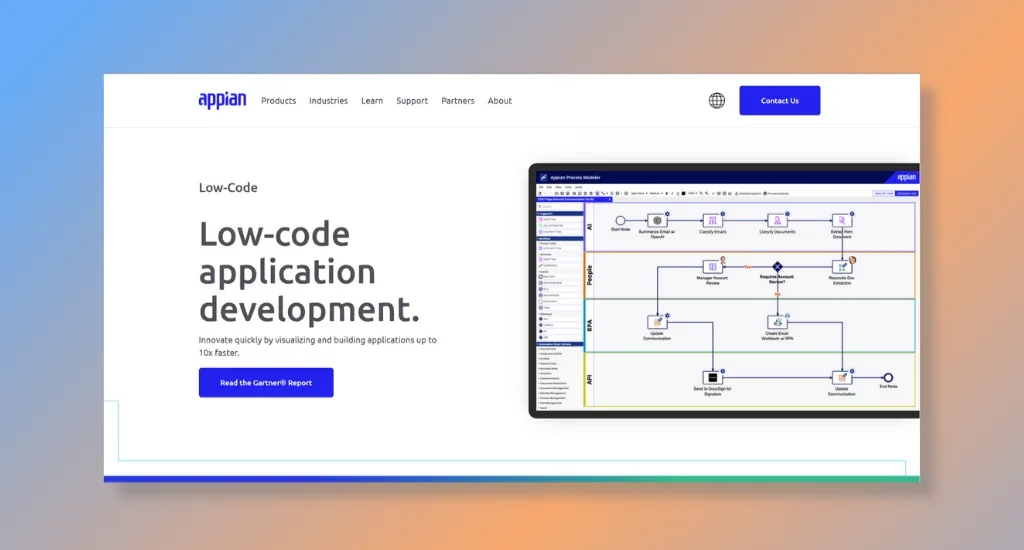
Appian specializes in providing low code automation tools for performance testing within their platform. Their expertise lies in supporting tools like JMeter and Locust, facilitating automated load testing for assessing application scalability and behavior.
They focus on enabling users to conduct performance tests efficiently to ensure applications scale and perform optimally during peak usage. This empowers clients to conduct comprehensive performance tests, ensuring applications can effectively handle production-like or peak usage scenarios.
Notable Features of Working with Appian
- Integration of JMeter and Locust: Seamlessly incorporate these performance testing tools into the low-code environment for efficient load testing.
- Automated Load Testing: Facilitate automated performance tests to assess scalability and behavior under various usage scenarios.
- Scalability Assessment: Enable users to evaluate application performance under varying data sizes and user interactions for optimization.
- Streamlined Performance Monitoring: Provide tools and capabilities for continuously monitoring application performance during testing phases.
Appian’s Pricing Plans
Appian offers various pricing plans tailored to suit different business needs. You can contact them through their official website's contact page to discuss your specific testing requirements.
They cater to various finance, government, and technology businesses. Specifically, they work with clients seeking robust performance testing capabilities alongside low code automation tools for enhancing application performance.
8. OctoPerf - Simplifying Load Testing through Low Code Automation Tools
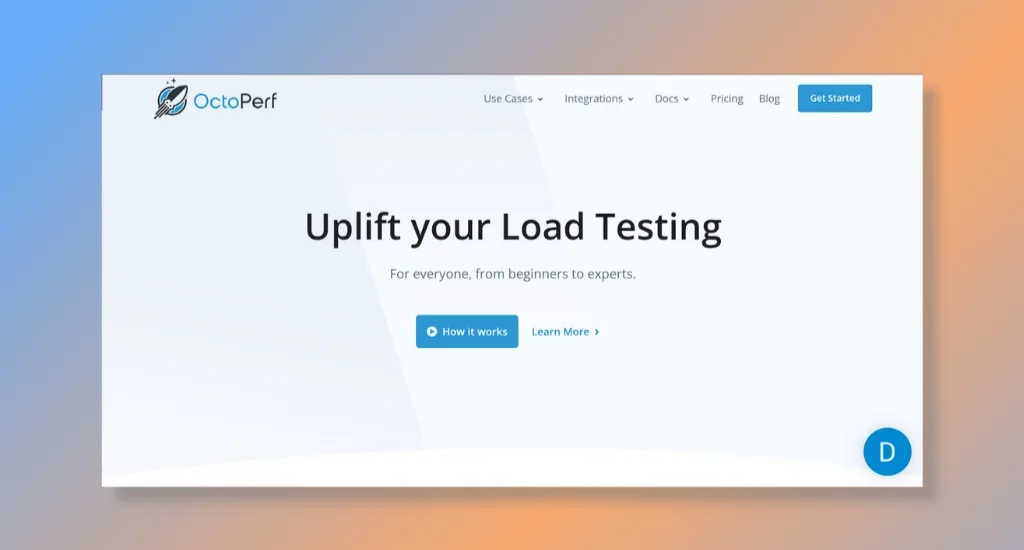
OctoPerf specializes in simplifying load testing experiences through low code automation tools. Their platform caters to users across all proficiency levels, offering a short learning curve and eliminating the need for coding. OctoPerf focuses on enabling teams to collaborate effectively and streamlining load testing processes.
Their services revolve around facilitating load testing with low code automation tools. Users can design virtual users effortlessly using auto-correlation rules and frameworks, enjoy automated cloud infrastructure setup globally within minutes, and access real-time customizable reports for comprehensive insights.
Notable Features of Working with OctoPerf
- Easy Load Testing Design: Utilize auto-correlation rules and frameworks for swift virtual user creation.
- Automated Cloud Infrastructure: Quickly initiate load test agents worldwide in minutes.
- Real-time Customizable Reports: Create tailored visualizations, compare results over time, and generate report templates.
- Export to JMeter: Seamlessly export data to JMX files for versatility in testing environments.
OctoPerf’s Pricing Plans
OctoPerf offers various pricing plans for user needs, including a free tier license for life. To find their pricing plans, visit their official website and navigate to the "Pricing" section. Once there, you'll find details about their various pricing tiers, available features, and specific offerings for different user needs.
They work with diverse businesses ranging from startups to enterprises across multiple industries, focusing on those seeking simplified load-testing experiences and leveraging low code automation tools for performance testing.
9. Opkey - Providing a Centralized Repository for Test Data and Results
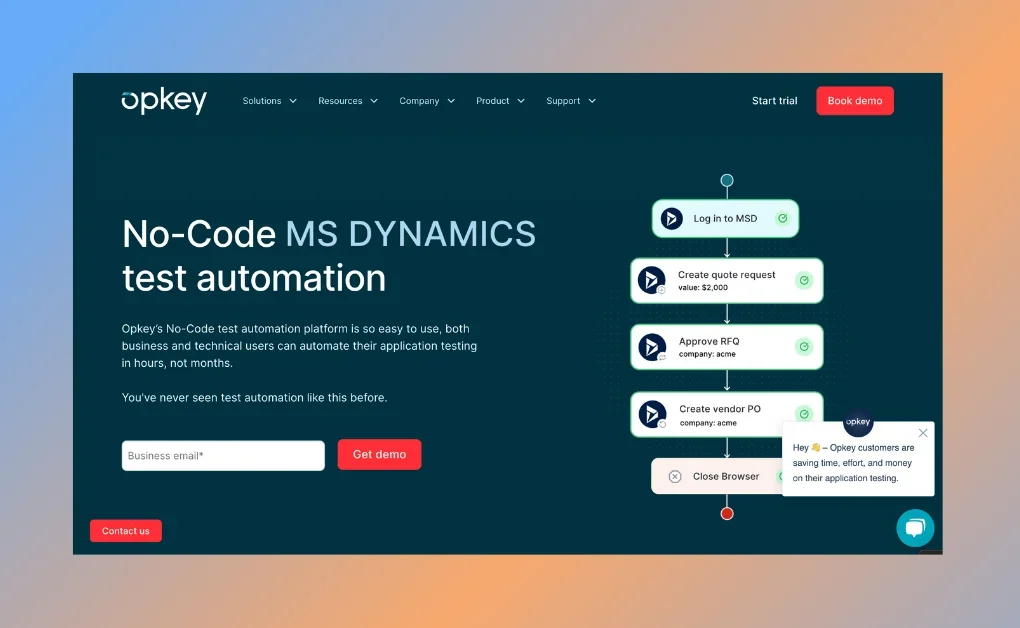
Opkey is renowned for its expertise in no-code test automation, explicitly excelling in performance testing aspects through low code automation tools. They offer a comprehensive platform catering to various applications and technologies, ensuring robust testing without extensive coding knowledge.
Their platform empowers clients by providing low code automation tools for performance testing, facilitating streamlined test creation and execution. Clients benefit from accelerated test cycles, reduced risk of app downtime, and significant cost savings due to the platform's ease of use and efficient automation capabilities.
Notable Features of Working with Opkey
- Low-Code Performance Testing: Opkey offers intuitive tools for performance testing without extensive coding requirements, enabling efficient test creation.
- Comprehensive Technology Support: The platform covers various applications and technologies, ensuring versatility in performance testing scenarios.
- Proactive Impact Analysis: Opkey's proactive alerts help identify potential test impacts before changes are implemented, ensuring thorough performance testing.
- Self-Healing Scripts: With self-healing technology, Opkey ensures that tests remain robust even as applications evolve, which is crucial for sustained performance testing accuracy.
Opkey’s Pricing Plans
Opkey's pricing structure aligns with the diverse needs of businesses, offering scalable plans based on usage and features required. Simply go to their website to explore Opkey's capabilities and get a personalized demonstration of their platform's features. This will give you a guided walkthrough and deeper insights into how Opkey can meet your testing requirements.
They collaborate with prominent enterprises across diverse sectors such as healthcare, construction, and technology, providing them with tailored solutions for low code automation tools in performance testing. Clients benefit from Opkey's specialized testing tools, enhancing their testing efficiency across different industries.
Essential Features of a Low Code Automation Tool
When developing low code automation tools, it's vital to integrate key features that enhance user-friendliness, streamline operations, and adapt to diverse operational needs. These features distinguish proficient tools from basic ones. Here are some considerations to take when determining the features for optimal tool functionality and user satisfaction:
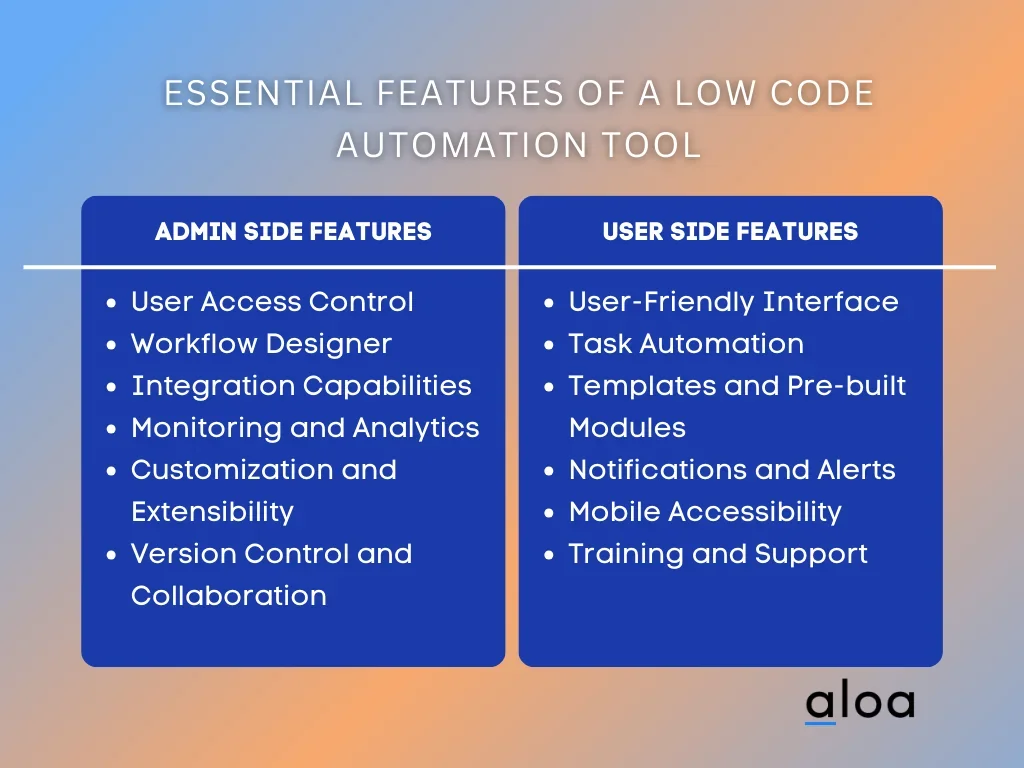
Admin Side Features of a Low Code Automation Tool
Administrators are crucial in configuring and overseeing the deployment of a low-code automation tool. These features empower them to manage and optimize automation processes efficiently, ensuring they align with organizational goals and requirements.
- User Access Control: Ability for admins to manage user permissions and access levels, ensuring security and control over who can modify or access various parts of the system.
- Workflow Designer: A visual interface that allows admins to create and modify workflows using drag-and-drop elements, enabling the design of complex automated processes without coding.
- Integration Capabilities: Tools that facilitate easy integration with various systems, databases, APIs, and applications, enabling seamless data exchange and automation across multiple low-code platforms.
- Monitoring and Analytics: Dashboard or reporting features that provide insights into system performance, usage statistics, and automation efficiency, allowing admins to optimize and troubleshoot processes.
- Customization and Extensibility: Options to extend the tool's functionality by adding custom code or scripts for more advanced automation requirements, offering flexibility for specific use cases.
- Version Control and Collaboration: Facilities for versioning workflows, allowing admins to track changes, collaborate with team members, and revert to previous versions if needed, ensuring better teamwork and control over modifications.
User Side Features of a Low Code Automation Tool
When considering a low-code automation tool from the user's standpoint, it's essential to examine how user-friendly, adaptable, and tailored it is to meet particular operational requirements. Here are crucial user-oriented features to take into account:
- User-Friendly Interface: Intuitive and easy-to-use interface for users to interact with the automation tool, enabling them to understand and execute tasks efficiently without extensive training.
- Task Automation: Ability for users to automate repetitive tasks by creating simple workflows or automation tailored to their specific needs, reducing manual effort and increasing productivity.
- Templates and Pre-built Modules: Access to a library of pre-built templates and modules that users can easily customize or use to accelerate the creation of automated processes.
- Notifications and Alerts: Functionality to set up notifications or alerts for users, informing them about task completion, errors, or any other relevant updates within the automation tool.
- Mobile Accessibility: Support for mobile devices, allowing users to manage and monitor automated tasks on the go through mobile applications or responsive web interfaces.
- Training and Support: Comprehensive documentation, tutorials, and customer support to assist users in learning the tool's features and resolving any issues they encounter during the automation process.
Steps in Choosing the Best Low Code Automation Tools
Choosing the best low code automation tools for 2024 requires an in-depth understanding of your automation needs, evaluating functionalities, vendor support, and cost-effectiveness. Discover the insights in our detailed guide for selecting low code automation tools. It will help you make smart decisions that match your automation aims and business productivity.
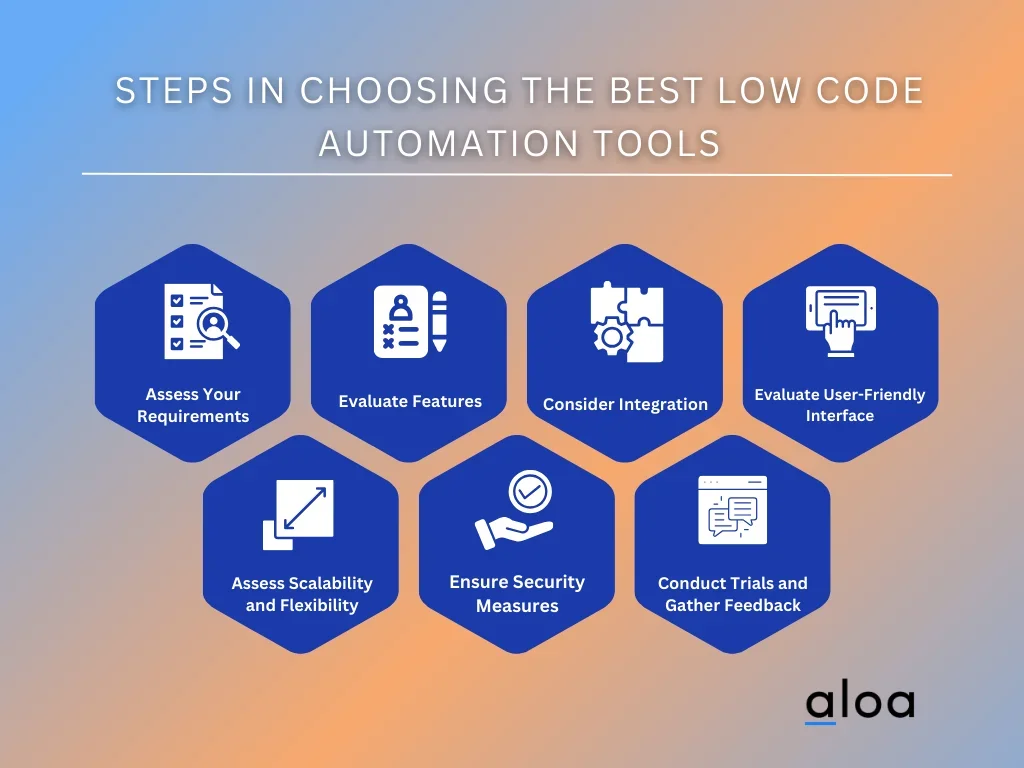
Step 1: Assess Your Requirements
Begin by thoroughly analyzing your business needs and the specific processes you aim to automate. Document the key objectives, challenges, and goals you expect the tool to address. Also, consider factors like scalability, complexity, integrations, and user requirements.
To make it easier for you, here are seven key aspects to consider when assessing your requirements for a low-code automation tool:
- Process Identification: Which specific business processes require automation? Are there repetitive tasks or workflows that can benefit from automation?
- Objectives and Goals: What primary objectives do you aim to achieve through automation?
- Complexity and Scalability: How complex are the processes intended for automation? Will these processes remain stable or require scalability in the future?
- User Requirements: Who are the primary users of the automation tool? What are their technical skills and comfort levels with technology?
- Integration Needs: Are there existing systems or tools the automation tool needs to integrate?
- Regulatory and Compliance Requirements: Are there industry-specific regulations or compliance standards to consider? What security and privacy measures must the tool adhere to?
- Budget and Timeline: What is the budget for implementing the automation tool? Is there a specific timeframe or deadline for the tool's implementation?
Step 2: Evaluate Features
After defining your requirements, compare the features of different low code automation tools. Create a checklist of essential functionalities that hold immense value in sculpting the efficiency and adaptability of the tool to your business ecosystem.
When choosing a low-code automation tool, these functionalities are crucial to evaluate, ensuring it aligns with your organization's needs and offers the required capabilities for efficient automation development and management.
- Drag-and-Drop Interface: This enables users to configure UI elements in their app interface effortlessly by dragging and connecting aspects without needing to code.
- Pre-built Templates: Provides templates for standard automation processes, offering a starting point for customization and quick deployment.
- Customization Options: Allows tailoring the tool to specific business needs through configurable settings, scripting, or APIs for advanced modifications.
- Workflow Design Capabilities: Provides robust tools to design complex workflows, including support for conditional logic, loops, and branching pathways.
- Reporting and Analytics: Offers features to generate detailed reports and analytics on automation performance, enabling insights into process efficiencies.
- Compatibility with Existing Systems: Ensures seamless integration with current software systems, allowing smooth data flow and interaction between tools.
- Scalability and Version Control: Allows scaling automation processes to accommodate business growth and provides version control for managing changes efficiently.
Step 3: Consider Integration
Next, assess the integration capabilities of each tool. Compile a list of your current software systems and inquire how seamlessly the low-code tools can integrate. Request demonstrations or trials to test these integrations firsthand.
Testing these integrations during trials or demonstrations provides a firsthand experience of how data flows between systems, highlighting potential bottlenecks or seamless connections. This step verifies technical compatibility and assesses the tool's adaptability to your organization's unique infrastructure, aiming for a cohesive and interconnected workflow.
Step 4: Evaluate User-Friendly Interface
Once you’re done considering each tool's integration capabilities, evaluate the tools' user-friendliness. Conduct usability tests or trials involving users with different technical skills. Also, emphasize ease of use and a visually intuitive development environment while leveraging artificial intelligence (AI) and machine learning for efficient process automation.
Understanding the user-friendliness of the interface extends beyond ease of use. It encompasses the intuitiveness of the tool's design, navigation simplicity, and adaptability to different user skill levels. It's about simplicity and how effectively the tool empowers users to navigate, create, and manage automated processes without extensive training.
Step 5: Assess Scalability and Flexibility
Then, consider the scalability potential of the tools. Inquire about their ability to accommodate growth and adapt to changing business needs. Seek details on customization options and how the tool supports scaling without significant rework.
Evaluating scalability entails assessing how effectively the tool adapts to increased demands without compromising performance. Flexibility in customization and scalability ensures that as your business evolves, the tool can seamlessly adjust to new requirements, preventing the need for frequent overhauls.
Step 6: Ensure Security Measures
Afterwards, prioritize security features. Assess each tool's compliance with industry standards, encryption protocols, user access controls, and data protection measures. Inquire about their history with security breaches or vulnerabilities.
Ensuring encryption, strict user access controls, regular updates, and a history devoid of significant security breaches or vulnerabilities are vital for safeguarding sensitive data and maintaining trust.
Step 7: Conduct Trials and Gather Feedback
Finally, before making a decision, take advantage of trials or demos offered by the tools. Involve key stakeholders from different departments in these trials. Gather their feedback and experiences to understand each tool's performance and suitability for your organization better.
Trials and demos serve as immersive experiences that transcend mere feature lists. They provide invaluable insights into the tool's operation within your unique business environment. Gathering feedback from diverse stakeholders captures user experiences and highlights specific functionalities that resonate positively or require improvement.
Key Takeaway
Choosing the right low code automation tools in 2024 is crucial for startups as they offer streamlined solutions without needing extensive technical skills. These tools provide industry-specific templates, customized workflows, and integrations for different sectors, making complex automation easy for non-tech users. They have made complex automation accessible to those without technical expertise, revolutionizing industries by fostering efficiency and innovation.
Adapting these tools enables startups to stay updated with industry demands, empowering them to swiftly adjust and meet evolving needs. This adaptability ensures they remain competitive and agile, capable of implementing efficient processes that enhance their market presence and scalability.
Don't hesitate to contact us at [email protected] for further details about innovative startups leveraging low code automation tools. We support your testing projects, offering comprehensive insights and guidance. Let's work together to propel your projects forward in this dynamic industry, creating impactful solutions that drive your success in 2024.

